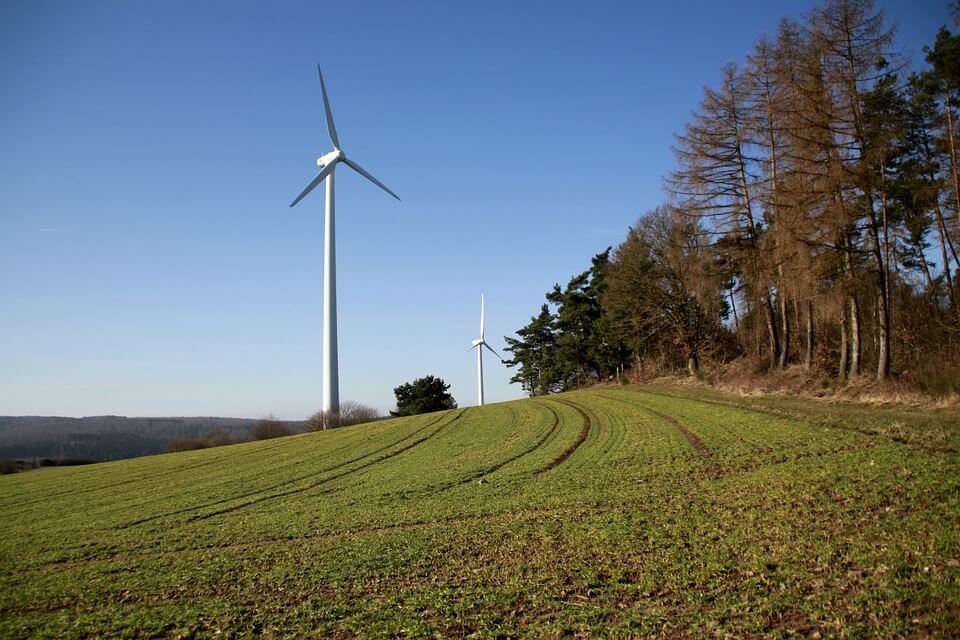Wind Farms.

Not just in Ireland but in many other countries across Europe are now working constructing wind-farms. This increasing activity stems from a previous agreed EC policy directive (2001/77/EC) known as the RES-E Directive. In this the EU stated a goal to have 22% of the total energy consumed by member states, to be produced from renewable energy resources by 2010. Ireland in 2015 it’s stated by the Irish Wind Energy Association, Ireland’s percentage from this natural source is now at 18.3%. Since 1992 and the building of Ireland’s first commercial wind farm at Bellacorrick, Co Mayo, the island now has a total of 228 wind-farms on the island. Of these, 195 reside within the Irish republic. In further numbers, it’s estimated that one thousand and eight hundred turbines now exist within Ireland daily working away to try provide power for Ireland.
Opposition to the farms speak about forecasts issues with the existing turbine stock which, in most cases, have a lifespan of 25 years. There are some claims that make out they may actually not last that long. Their argument is that replacing them will also cost money while even if some turbines are removed you have a further clean-up operation linked to their concrete bases.
Wind farming in Ireland is a subsidised industry which has been mentioned, attracted an artificial level of interest from investors and developers. While every development requires an Environmental Impact Study, individual or community opposition to them has queried whether or not the aggregate effect of turbines dotted around a county has been fully taken into account. Beyond the aesthetic debate there is also the querying of short/long-term economic benefits of wind. Debates are often centred on a core issue that despite it being a natural blowing energy resource which Ireland has in abundant supply; it is not necessarily blowing money our way.
.
Specifics.
Facts as presented by Dr Paul Deane of the Environmental Research Institute at University College Cork, are as follows: Ireland is one of the most energy-dependant countries in Europe, spending €6.9bn on fuel in 2013 (source: CSO) importing over 89% of our energy (SEAI). Ireland is the third highest emitter of Green House Gases per capita in Europe (source: EPA).
Ireland has an ambitious mandatory target for renewable energy arising from the EU Renewable Energy Directive (2009/28/EC). Ireland’s EU target of 16% in renewable energy by 2020 breaks out into 10% of energy in transport, 12% of energy in heating and 40% of energy in electricity must be renewable. If these figures are to be achieved, then we must continue onward. We would not dispute this. That said, again we should take the position to protect first, our priceless natural assets which we have already. This means our very landscape all around Ireland and its aesthetic appearance. This is something you cannot put a specific financial price on – nor should we try. People – and planet – before profit.
When it comes to wind-farms there is are two different power levels. The first is in which the larger set-ups are placing energy into the national grid and there are smaller ones are typically powering an immediate domestic/agricultural situation. ESB Networks generally deal with the smaller operators while Eirgrid manages the larger ones. Sole trader-type turbine operators argue that there are insufficient grants and tariffs available to them while large-scale wind energy is subsidised through the REFIT mechanism (Renewable Energy Feed-in-Tariff).
It should be noted also that it is the larger developments that are the focus of Ireland’s attempts to get close to set 2020 targets. As regards the business aspect of wind-farms, it’s clear that there are areas that need to be further delved into and adjusted to ensure that fairness and financial controls are batter balanced.
.

Presently it appears that wind energy is still at times more expensive than coal and gas. The Euro cost of wind energy has been falling slowly. The cost of coal and gas has been declining rapidly. We got to ask the question “Is it further a wise investment at the moment?” It’s a question – not a statement of opposition but it’s a matter that we should feel, needs to be further looked at and then addressed. We are aware – and should always be – that technology is improving in the direction of wind power. No possible pun intended.
The company Amazon for example, has announced (Aug’ 24th 2020) that they are to build a third Irish wind farm (news LINK) to meet a climate pledge made. Credit to them for that. In total, if the PR end of things is accurate, their three “Amazon renewable projects help Irish energy consumers avoid an estimated €229m ($271m) Public Service Obligation (PSO) subsidy cost on their energy bills”. Any reductions that tax nature at a cost and humans, is very much welcomed by UnitedPeople. We would support such efforts from companies looking to do same.
.
Other Connected Matters.
One matter that also needs to be further overall taken into account, is the glaring fact Ireland is on the Western shore of Europe. Acknowledging this as well as the actual location of a wind farm in Ireland, we find that to export to major electricity markets could still be more expensive than is liked or as a long terms viable option. UnitedPeople therefore would look at this matter for a resolvent stable solution.
A second matter is that while this area of power production continues to grow, manufacturing facilities been established within Ireland, setting up a factory in Ireland is economically challenging to say the least if only besides other factors, that the demand for turbines in Ireland is too small and thus shipping is expensive for transport further afield. The economically challenging part will have to be clearly addressed and viable, realistic solutions found.
Subsidies in the short term are an aid to overcome this but should then be a long-term investment? We think not. Ireland doesn’t need another financial bottomless pit. We cannot see any answers from our current elected (Aug’2020) or even the question being raised yet in the Dáil!
We as a nation certainly should be – and UnitedPeople would like to be – delving into a Life Cycle Assessment (LCA) of turbines in relation to carbon emissions under certain conditions. Concern has been raised as regards siting wind turbines on peatland which could release considerable carbon dioxide from said peat.
To quote a 2014 Northern Ireland Environment Agency report:
“The potential knock-on effects of using the peatland resource for wind turbines are considerable.” LINK
These are matters that are close to the heart of Irish people and the very land they rest upon.
In a Life Cycle Assessment of wind-farms and the default position priority being to protest the natural Irish environments, serious questions have to be asked in regard to:
- Upon the construction of a wind farm how does this daily lifestyle effect those there that have previously purchased a living accommodation?
- The ability just to sell property when a wind farm is later located nearby – how can this be done fairly in respect to a financial investment/cost to owners of earlier gained properties?
- How will erection of wind-farms effect taxes places upon surrounding properties?
- How will the erection of wind-farms effect local tourist abilities on a basis of scenic and other factors?
- Is there a noise factor and how might it be detrimental to human or animal life in the area?
- Would such a wind farm truly bring long-term employment to an area or be detrimental to it?
We absolute believe strongly that where possible, we have to retain that which makes Ireland historic, environmental and aesthetic different. It is important to maintain that which makes our country special from others. When this means we choose to protect our invaluable diverse people over profit as a default position, we chose this position positively and without hesitation. We have got to seek greater protections for citizens, now and future ones, combined with their equal protected environment, to long enjoy.
That said, if environmental, non-damaging solutions can be found to the matter of wind turbines, we welcome Ireland going in the direction of such possibilities. UnitedPeople wishes to actively work toward viable long terms solutions that are good for our land, animals, resources and for our citizens in health terms besides also in financial gain aspect.
